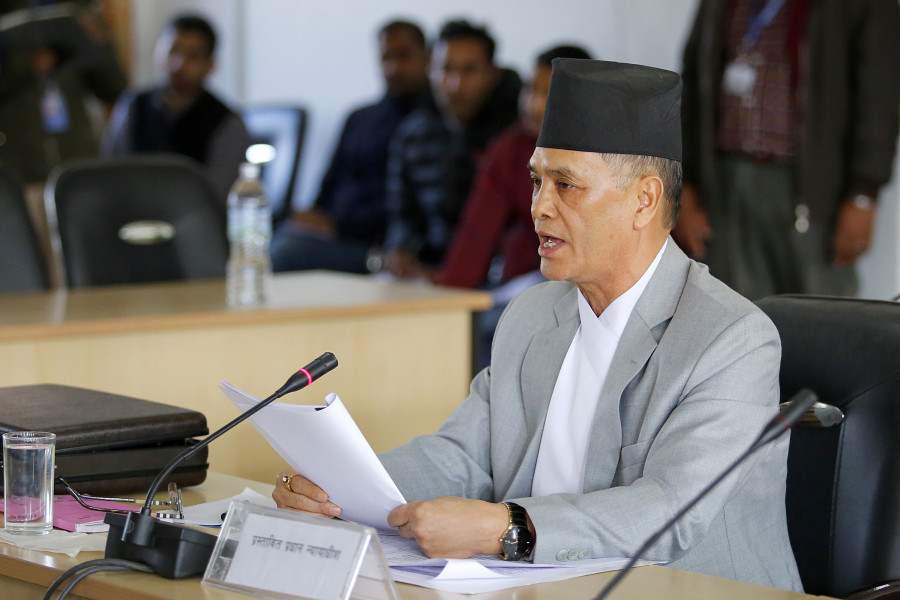National
Chief justice mandatorily chairing Constitutional Bench exposes a major oversight by charter drafters
Recommendations of Constitutional Council meeting attended by Rana have been challenged at the Constitutional Bench. Can he sit on the bench which has to decide on a case which has his involvement?
Prithvi Man Shrestha & Binod Ghimire
Nepal’s present constitution was seven years in the making. It took two 601-member Constituent Assemblies, elected in 2008 and again in 2013 as the first one could not agree on the finer points, and billions of rupees for one to be finally drafted.
When it was promulgated on September 20, 2015, leaders thumped their chests claiming it to be the best constitution in the world.
The subsequent general elections in 2017 based on the new constitution, installed KP Sharma Oli as the prime minister in February 2018.
However, Oli’s actions over the past years have not only weakened the constitution but also exposed some fundamental flaws its drafters had failed to foresee.
Days before he dissolved the House of Representatives, Oli on December 15 had introduced an ordinance on the Constitutional Council Act, amending some provisions regarding the quorum for the holding of the meeting and making recommendations.
As per the constitutional provisions, the Council is led by the prime minister with chief justice, House Speaker and deputy Speaker, National Assembly chair and leader of the main opposition as members.
After massive criticism, Oli agreed to withdraw the ordinance but he did not. Instead, the Council made some recommendations.
As many as three separate petitions were filed at the Supreme Court challenging the recommendations made by the Council. The petitions were sent to the Constitutional Bench to test the constitutional validity of the recommendations.
And here’s the catch.
In his writ petition against the ordinance and subsequent recommendations by the Constitutional Council, advocate Om Prakash
Aryal has named Chief Justice Cholendra Shumsher Rana as one of the defendants. As a member of the Council, Rana was present in the meeting that made the recommendations.
Lawyers are now questioning if the chief justice can sit on the bench which is hearing a case on which he is one of the defendants.
As per the principle of natural justice, party to a dispute cannot sit on a bench that is tasked with delivering justice.
Legal experts say that the case has highlighted the shortcomings of the constitution.
According to Balram KC, a former Supreme Court justice, making the provision for the chief justice to be part of the Constitutional Council was a mistake.
“Recommending names for constitutional bodies is purely an administrative task,” KC told the Post. “The chief justice of the country should not have been accommodated in the Council. This is one of the defects of the constitution.”
In the judicial process, justices often follow their own wisdom, instinct and convention and decide to recuse themselves whenever a conflict of interests arises.
Though a little late, Justice Hari Krishna Karki on Wednesday recused himself from continuing hearing on the writs petitioned against the Oli government’s House dissolution move after lawyers questioned why he was present on the Constitutional Bench.
Lawyers had argued that since Karki as attorney general in 2015 had served as the legal counsel to Oli and his government then, he could not hear the writs that have made Oli the defendant.
The problem with regards to the constitutional appointment recommendations, however, is that the chief justice cannot recuse himself.
It’s because of the failure of the drafters of the constitution to foresee such a situation, according to some legal experts.
Article 137 (1) of the constitution says the chief justice and four other Supreme Court justices will constitute the Constitutional Bench.
The constitution does not envision the Constitutional Bench without the chief justice.
Bipin Adhikari, former dean of the Kathmandu University School of Law, said the constitution makers failed to see a situation where the chief justice could be a defendant in a case which would require a serious constitutional explanation, meaning the case must be heard by the Constitutional Bench.
“They failed to insert the exception clause which invited the current situation,” Adhikari told the Post.
Article 137 (3) authorises the chief justice to allocate the cases under consideration at the Supreme Court containing questions of serious constitutional explanation to the Constitutional Bench.
At least three leaders, who were in the Constitution Drafting Committee of the Constituent Assembly, the Post talked to admitted that they couldn’t foresee such a situation during the drafting process.
Krishna Bhakta Pokharel, a member of the Judiciary Committee under the drafting committee, said their discussions were more focused on whether to constitute a separate Constitutional Court or to go for a Constitutional Bench.
He said that the decision to have a provision for a Constitutional Bench was a compromise, as the Nepali Congress and the erstwhile CPN-UML did not want a separate Constitutional Court and instead wanted all the issues related to the constitution to be decided by the Supreme Court.
“So we took a middle path and agreed on the Constitutional Bench,” Pokharel told the Post. “The present dilemma wouldn’t have arisen had we agreed not to form any such mechanism.”
While the option between a Constitutional Court and a Constitutional Bench was debated for days, there was no foresight that mandatory involvement of the chief justice might invite trouble, according to those involved in the constitution drafting process.
“The problem would have been sorted out had we included a line saying chief justice or the senior most justice of the Supreme Court would lead the Constitutional Bench,” Rewati Raman Bhandari, a member of the drafting committee, told the Post. “We must admit that there are lapses in the constitution.”
But some members of the Constituent Assembly, who were directly involved in the drafting process, are more sanguine about it and say the constitution is an evolving document and it can be amended as and when necessary.
“There are many issues that surface with practice,” Sher Bahadur Tamang, another member of the drafting committee, told the Post. “We have to rectify them.”
According to Tamang, who was also a law minister in the Oli Cabinet, too said a Constitutional Bench became a part of the constitution as a compromise.
Adhikari said that if the current situation has brought to the fore the shortcomings in the constitution, it has also provided an opportunity to set precedents, as the Supreme Court, after all, is the ultimate arbiter of the country’s top law.
“Everything is not written in a constitution and the Supreme Court has the right to interpret it,” said Adhikari. “As per the principle of casus omissus, the Supreme Court can fill up the gap in the constitution and law based on other principles of constitution and recognised principle of justice.”
Oli’s decision to dissolve the House has put the country’s judiciary to the test, with opinions divided over whether his move is constitutionally valid. Experts on constitutional matters have called Oli’s action outright unconstitutional. Oli and his loyalists, however, have been trying to justify his move, saying the constitution “does allow” him to dissolve the House. On Friday, four former chief justices issued a statement, describing the House dissolution as an unconstitutional move.
Some media reports even suggest Oli took the step in close consultation with the chief justice.
During the first hearing on a regular bench against the House dissolution on December 23, Chief Justice Rana had even asked one of the lawyers why “it is wrong when a prime minister elected under Article 76 wants to seek a fresh mandate”, exactly the same argument Oli has been making to defend his House dissolution move.
As far as writs against Constitutional Council recommendations are concerned, according to KC, the Constitutional Bench should proceed without the chief justice.
“From the perspective of fair hearing and trial, the chief justice should not be part of the bench which has to test the constitutionality of a decision of which he is a part,” KC told the Post. “The best option would be for the chief justice to avoid the Constitutional Bench by declaring that despite the constitutional provision, he has formed the bench minus him because he himself is a defendant in the case.”
Senior advocate Bhimarjun Acharya, who specialises on constitutional law, however, said that there is no need for the chief justice to avoid the Constitutional Bench even though there is a conflict of interest because of a clear constitutional provision.
“We should not expect the chief justice not chairing the Constitutional Bench and not participating in decision-making,” he said. “But he and other judges on the bench must be impartial on their decision making based on the merit of the case. This could be the best option available today.”
The principle behind the five-member Constitutional Bench is a decision can be taken on majority basis when justices have different opinions.
If the chief justice does continue on the bench but does not give his opinion because he is party to the case, a possibility of a deadlock in making the final decision could arise.
Pokharel, the member of the Constitution Drafting Committee of the Constituent Assembly, said the case can be sent to the full bench of the Supreme Court instead of the Constitutional Bench if the chief justice cannot hear it because he is party to it.
“There is no constitutional compulsion that the Constitutional Bench has to hear the writ,” Pokhrel told the Post. “It can be resolved by the full bench sans the chief justice.”




 12.12°C Kathmandu
12.12°C Kathmandu











%20(1).jpg&w=300&height=200)



